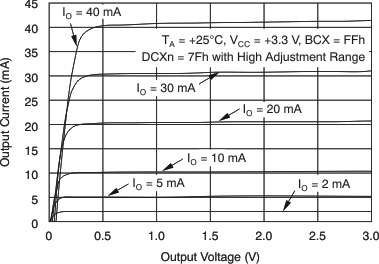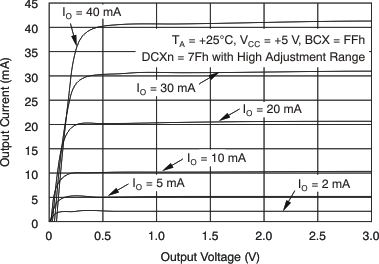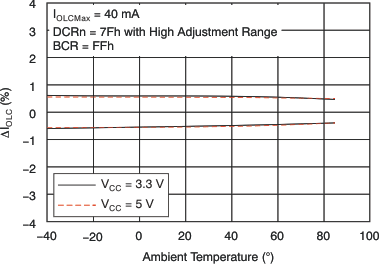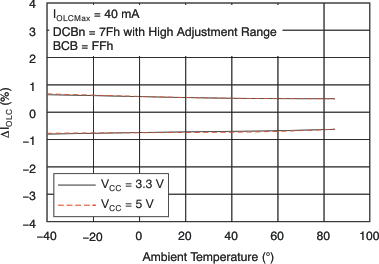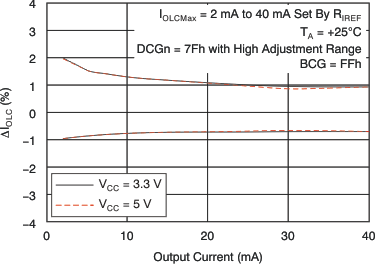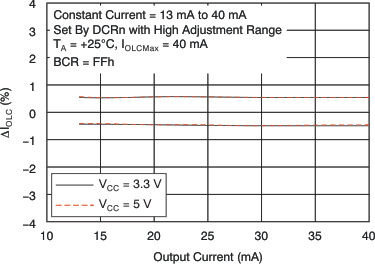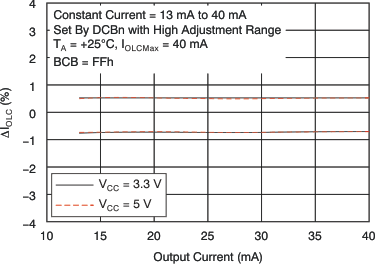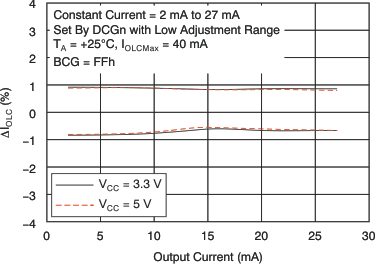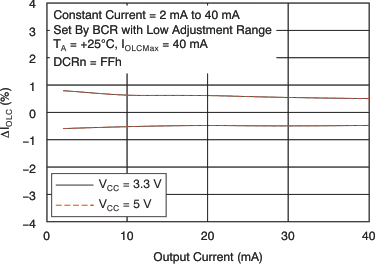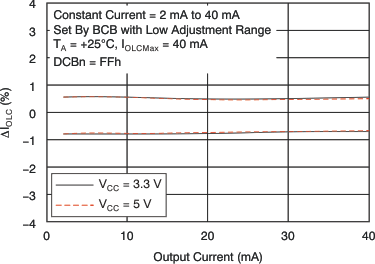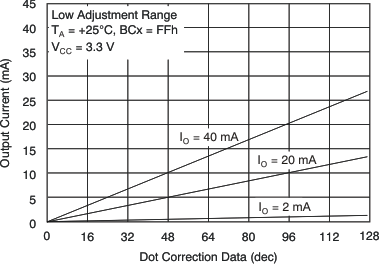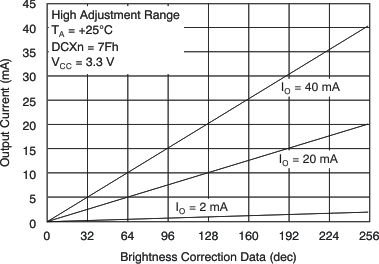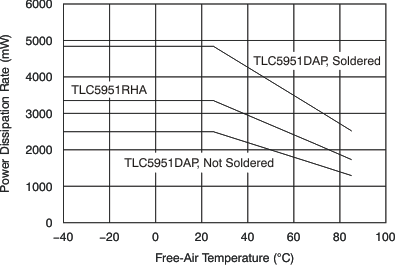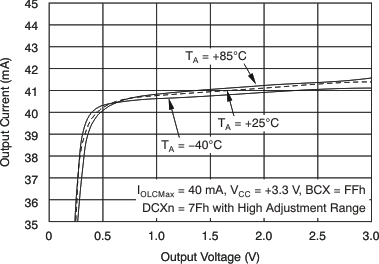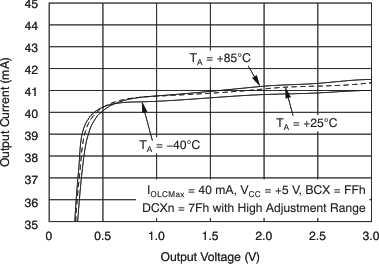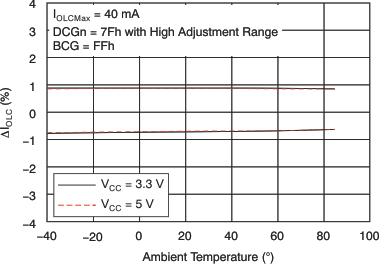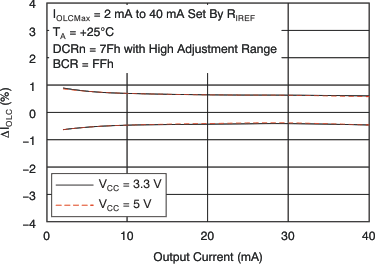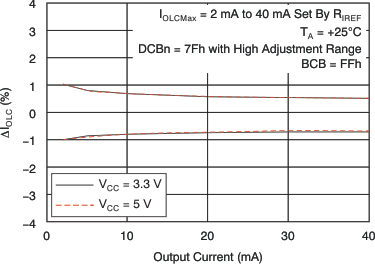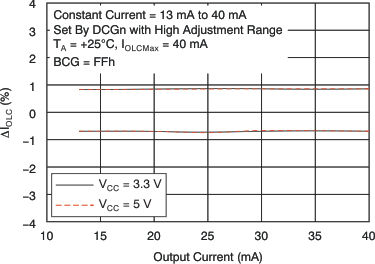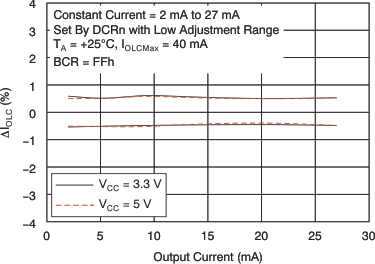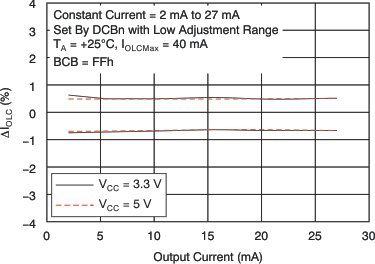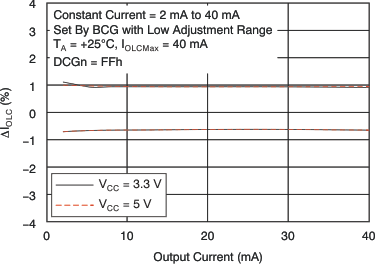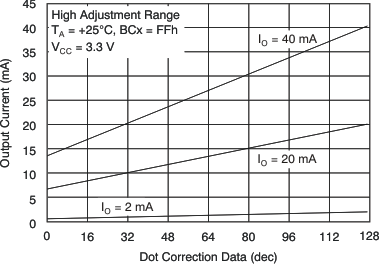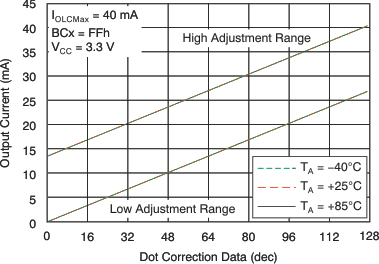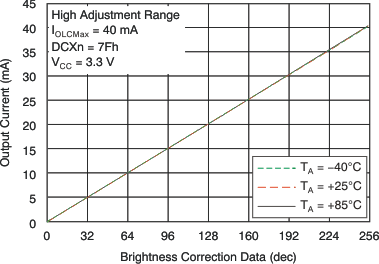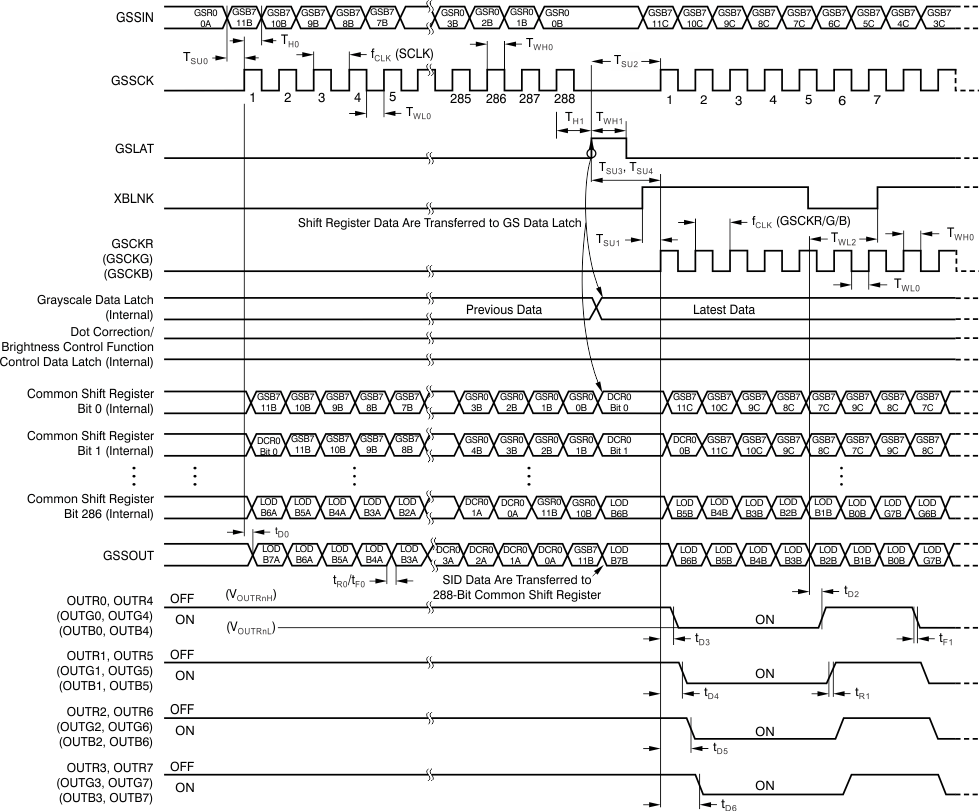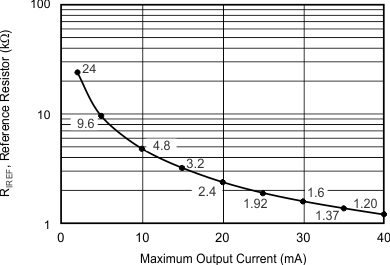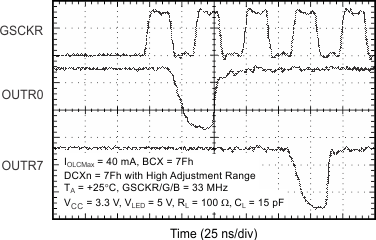SBVS127E March 2009 – July 2017 TLC5951
PRODUCTION DATA.
- 1 Features
- 2 Applications
- 3 Description
- 4 Revision History
- 5 Description (Continued)
- 6 Pin Configuration and Functions
- 7 Specifications
- 8 Parameter Measurement Information
-
9 Detailed Description
- 9.1 Overview
- 9.2 Functional Block Diagram
- 9.3 Feature Description
- 9.4
Device Functional Modes
- 9.4.1 Maximum Constant Sink-Current Value
- 9.4.2 Dot Correction (DC) Function
- 9.4.3 Global Brightness Control (BC) Function
- 9.4.4 Grayscale (GS) Function (PWM Control)
- 9.4.5 Register and Data Latch Configuration
- 9.4.6 Status Information Data (SID)
- 9.4.7 Continuous Base LOD, LSD, and TEF
- 10Device and Documentation Support
- 11Mechanical, Packaging, and Orderable Information
Package Options
Mechanical Data (Package|Pins)
Thermal pad, mechanical data (Package|Pins)
Orderable Information
7 Specifications
7.1 Absolute Maximum Ratings(1) (2)
Over operating ambient temperature range, unless otherwise noted.
(1) Stresses beyond those listed under Absolute Maximum Ratings may cause permanent damage to the device. These are stress ratings only, which do not imply functional operation of the device at these or any other conditions beyond those indicated under Recommended Operating Conditions. Exposure to absolute-maximum-rated conditions for extended periods may affect device reliability.
(2) All voltage values are with respect to network ground terminal.
7.2 ESD Ratings
| VALUE | UNIT | |||
|---|---|---|---|---|
| V(ESD) | Electrostatic discharge | Human-body model (HBM), per ANSI/ESDA/JEDEC JS-001(1) | ±2000 | V |
| Charged-device model (CDM), per JEDEC specification JESD22-C101(2) | ±500 | |||
(1) JEDEC document JEP155 states that 500-V HBM allows safe manufacturing with a standard ESD control process.
(2) JEDEC document JEP157 states that 250-V CDM allows safe manufacturing with a standard ESD control process.
7.3 Recommended Operating Conditions
At TA = –40°C to 85°C, unless otherwise noted.7.4 Thermal Information
| THERMAL METRIC(1) | TLC5951 | UNIT | |||
|---|---|---|---|---|---|
| DAP (HTSSOP) | RHA (VQFN) | RTA (WQFN) | |||
| 38 PINS | 40 PINS | 40 PINS | |||
| RθJA | Junction-to-ambient thermal resistanceDeleted Dissipation Ratings | 27.8 | 28 | 27.2 | °C/W |
| RθJC(top) | Junction-to-case (top) thermal resistance | 14.7 | 27.7 | 12.4 | °C/W |
| RθJB | Junction-to-board thermal resistance | 6.7 | 9.3 | 8.7 | °C/W |
| ψJT | Junction-to-top characterization parameter | 0.2 | 0.2 | 0.1 | °C/W |
| ψJB | Junction-to-board characterization parameter | 6.8 | 9.3 | 8.6 | °C/W |
| RθJC(bot) | Junction-to-case (bottom) thermal resistance | 0.6 | 1.3 | 0.9 | °C/W |
(1) For more information about traditional and new thermal metrics, see Semiconductor and IC Package Thermal Metrics.
7.5 Electrical Characteristics
At TA = –40°C to 85°C, VCC = 3 V to 5.5 V, and VLED = 5 V, unless otherwise noted. Typical values are at TA = 25°C and VCC = 3.3 V.| PARAMETER | TEST CONDITIONS | MIN | TYP | MAX | UNIT | |
|---|---|---|---|---|---|---|
| VOH | High-level output voltage | At GSSOUT, DCSOUT, IOH = –1 mA | VCC – 0.4 | VCC | V | |
| VOL | Low-level output voltage | At GSSOUT, DCSOUT, IOL = 1 mA | 0.4 | V | ||
| II | Input current | At GSSCK, GSLAT, DCSIN, DCSCK, GSCKR, -G, -B with VI = VCC, At GSSIN, GSSCK, GSLAT, DCSIN, XBLNK, DCSCK, GSCKR, -G, -B with VI = GND |
–1 | 1 | μA | |
| ICC1 | Supply current | GSSIN, GSSCK, GSLAT, DCSIN, DCSCK = low, XBLNK = low, GSCKR, -G, -B = low, VOUTRn/Gn/Bn = 1 V, BCR, -G, -B = FFh, DCRn, -Gn, -Bn = 7Fh with DC high adjustment range, RIREF = 24 kΩ (IOUTRn/Gn/Bn = 2 mA target) |
1 | 3 | mA | |
| ICC2 | GSSIN, GSSCK, GSLAT, DCSIN, DCSCK = low, XBLNK = low, GSCKR, -G, -B = low, VOUTRn/Gn/Bn = 1 V, BCR, -G, -B = FFh, DCRn, -Gn, -Bn = 7Fh with DC high adjustment range, RIREF = 2.4 kΩ (IOUTRn/Gn/Bn = 20 mA target) |
6 | 10 | mA | ||
| ICC3 | GSSIN, GSSCK, GSLAT, DCSIN, DCSCK = low, XBLNK = high, GSCKR, -G, -B = 33 MHz, VOUTRn/Gn/Bn = 1 V, GSRn, -Gn, -Bn = FFFh, BCR, -G, -B = FFh, DCRn, -Gn, -Bn = 7Fh with DC high adjustment range, RIREF = 2.4 kΩ (IOUTRn/Gn/Bn = 20 mA target), auto repeat on |
12 | 27 | mA | ||
| ICC4 | GSSIN, GSSCK, GSLAT, DCSIN, DCSCK = low, XBLNK = high, GSCKR, -G, -B = 33 MHz, VOUTRn/Gn/Bn = 1 V, GSRn, -Gn, -Bn = FFFh, BCR, -G, -B = FFh, DCRn, -Gn, -Bn = 7Fh with DC high adjustment range, RIREF = 1.2 kΩ (IOUTRn/Gn/Bn = 40 mA target), auto repeat on |
21 | 55 | mA | ||
| IOLC | Constant output current | At OUTR0–OUTR7, OUTG0–OUTG7, OUTB0–OUTB7, All OUTRn, -Gn, -Bn = on, BCR, -G, -B = FFh, DCRn, -Gn, -Bn = 7Fh with DC high adjustment range, VOUTRn/Gn/Bn = 1 V, VOUTfix = 1 V, RIREF = 1.2 kΩ (IOUTRn/Gn/Bn = 40 mA target) |
35 | 40 | 45 | mA |
| IOLKG | Leakage output current | At OUTR0–OUTR7, OUTG0–OUTG7 and OUTB0–OUTB7, XBLNK = low, VOUTRn/Gn/Bn = VOUTfix = 15 V, RIREF = 1.2 kΩ |
0.1 | μA | ||
| ΔIOLC | Constant-current error(1)
(channel-to-channel in same color group) |
At OUTR0–OUTR7, OUTG0–OUTG7 and OUTB0–OUTB7, All OUTRn, -Gn, -Bn = on, BCR, -G, -B = FFh, DCRn, -Gn, -Bn = 7Fh with DC high adjustment range, VOUTRn/Gn/Bn = 1 V, VOUTfix = 1 V, RIREF = 1.2 kΩ (IOUTRn/Gn/Bn = 40 mA target) |
±1.5% | ±4% | ||
| ΔIOLC1 | Constant-current error(2)
(color group to color group in same device) |
At OUTR0–OUTR7, OUTG0–OUTG7 and OUTB0–OUTB7, All OUTRn, -Gn, -Bn = on, BCR, -G, -B = FFh, DCRn, -Gn, -Bn = 7Fh with DC high adjustment range, VOUTRn/Gn/Bn = 1 V, VOUTfix = 1 V, RIREF = 1.2 kΩ (IOUTRn/Gn/Bn = 40 mA target) |
±1% | ±3% | ||
| ΔIOLC2 | Constant-current error(3)
(device to device) |
At OUTR0–OUTR7, OUTG0–OUTG7 and OUTB0–OUTB7, All OUTRn, -Gn, -Bn = on, BCR, -G, -B = FFh, DCRn, -Gn, -Bn = 7Fh with DC high adjustment range, VOUTRn/Gn/Bn = 1 V, VOUTfix = 1 V, RIREF = 1.2 kΩ (IOUTRn/Gn/Bn = 40 mA target) |
±1% | ±6% | ||
| ΔIOLC3 | Line regulation(4) | At OUTR0–OUTR7, OUTG0–OUTG7 and OUTB0–OUTB7, All OUTRn, -Gn, -Bn = on, BCR, -G, -B = FFh, DCRn, -Gn, -Bn = 7Fh with DC high adjustment range, VOUTRn/Gn/Bn = 1 V, VOUTfix = 1 V, RIREF = 1.2 kΩ (IOUTRn/Gn/Bn = 40 mA target) |
±0.5 | ±2 | %/V | |
| ΔIOLC4 | Load regulation(5) | At OUTR0–OUTR7, OUTG0–OUTG7 and OUTB0–OUTB7, All OUTRn, -Gn, -Bn = on, BCR, -G, -B = FFh, DCRn, -Gn, -Bn = 7Fh with DC high adjustment range, VOUTRn/Gn/Bn = 1 V, VOUTfix = 1 V, RIREF = 1.2 kΩ (IOUTRn/Gn/Bn = 40 mA target) |
±1 | ±3 | %/V | |
| ΔIOLC5 | Constant-current error(6)(7)
(channel-to-channel in same device) |
At OUTR0–OUTR7, OUTG0–OUTG7, and OUTB0–OUTB7, All OUTRn, -Gn, -Bn = On, BCR, -G, -B = FFh, DCRn, -Gn, -Bn = 7Fh with DC high adjustment range, VOUTRn/Gn/Bn = 0.5 V, TA = 25°C, RIREF = 9.6 kΩ (IOUTRn/Gn/Bn = 5 mA target) |
10% | |||
| ΔIOLC6 | Constant-current error(7)(8)(9)
(device-to-device) |
At OUTR0–OUTR7, OUTG0–OUTG7, and OUTB0–OUTB7, All OUTRn, -Gn, -Bn = On, BCR, -G, -B = FFh, DCRn, -Gn, -Bn = 7Fh with DC high adjustment range, VOUTRn/Gn/Bn = 0.5 V, TA = 25°C, RIREF = 9.6 kΩ (IOUTRn/Gn/Bn = 5 mA target) |
12% | |||
| TTEF | Thermal error flag threshold(10) | Junction temperature | 150 | 163 | 175 | °C |
| THYS | Thermal error flag hysteresis(10) | Junction temperature | 5 | 10 | 20 | °C |
| VLOD | LED open-detection threshold | All OUTRn, -Gn, -Bn = on | 0.2 | 0.25 | 0.3 | V |
| VLSD | LED short-detection threshold | All OUTRn, -Gn, -Bn = on | 2.4 | 2.5 | 2.6 | V |
| VIREF | Reference voltage output | RIREF = 1.2 kΩ | 1.17 | 1.2 | 1.23 | V |
| RPDWN | Pulldown resistor | At XBLNK, GSSIN | 250 | 500 | 750 | kΩ |
(1) The deviation of each output in the same color group from the average of the same color group (OUTR0–OUTR7, OUTG0–OUTG7, or OUTB0–OUTB7) constant current. The deviation is calculated by the formula  , where (X = R, G, or B; n = 0–7).
, where (X = R, G, or B; n = 0–7).
 , where (X = R, G, or B; n = 0–7).
, where (X = R, G, or B; n = 0–7).
(2) The deviation of each color group in the same device from the average of all constant current. The deviation is calculated by the formula  , where (X = R, G, or B).
, where (X = R, G, or B).
 , where (X = R, G, or B).
, where (X = R, G, or B).
(3) The deviation of the constant-current average from the ideal constant-current value. The deviation is calculated by the formula 
Ideal current is calculated by the formula

Ideal current is calculated by the formula

(4) Line regulation is calculated by  , where (X = R, G, or B; n = 0–7).
, where (X = R, G, or B; n = 0–7).
 , where (X = R, G, or B; n = 0–7).
, where (X = R, G, or B; n = 0–7).
(5) Load regulation is calculated by  , where (X = R, G, or B; n = 0–7).
, where (X = R, G, or B; n = 0–7).
 , where (X = R, G, or B; n = 0–7).
, where (X = R, G, or B; n = 0–7).
(6) The deviation of the maximum of all 24 channels from the minimum of all 24 channels of the same device. The deviation is calculated by  .
.
 .
.
(7) Applicable only to QFN-40 package.
(8) The deviation of the maximum of all 24 channels of 30 devices from the minimum of all 24 channels of 30 devices. The deviation is calculated by  .
.
 .
.
(9) Not production tested, verified by characterization.
(10) Not tested; specified by design.
7.6 Switching Characteristics
At TA = –40°C to 85°C, VCC = 3 V to 5.5 V, CL = 15 pF, RL = 100 Ω, RIREF = 1.2 kΩ, and VLED = 5 V, unless otherwise noted. Typical values are at TA = 25°C and VCC = 3.3 V.| PARAMETER | TEST CONDITIONS | MIN | TYP | MAX | UNIT | |
|---|---|---|---|---|---|---|
| tR0 | Rise time | GSSOUT, DCSOUT | 6 | 15 | ns | |
| tR1 | OUTR0–OUTR7, OUTG0–OUTG7, OUTB0–OUTB7, with BCR, -G, -B = FFh and DCRn, -Gn, -Bn = 7Fh with DC high adjustment range |
10 | 30 | ns | ||
| tF0 | Fall time | GSSOUT, DCSOUT | 6 | 15 | ns | |
| tF1 | OUTR0–OUTR7, OUTG0–OUTG7, OUTB0–OUTB7, with BCR, -G, -B = FFh and DCRn, -Gn, -Bn = 7Fh with dc high adjustment range |
10 | 30 | ns | ||
| tD0 | Propagation delay | GSSCK↑ to GSSOUT, DCSCK↑ to DCSOUT | 15 | 25 | ns | |
| tD1 | GSLAT↑ to GSSOUT | 50 | 100 | ns | ||
| tD2 | XBLNK↓ to OUTR0, OUTG0, OUTB0, OUTR4, OUTG4, OUTB4 off | 20 | 40 | ns | ||
| tD3 | GSCKR, -G, -B↑ to OUTR0/G0/B0, OUTR4/G4/B4 on, with BCR, -G, -B = FFh and DCRn, -Gn, -Bn = 7Fh with DC high adjustment range |
5 | 18 | 40 | ns | |
| tD4 | GSCKR, -G, -B↑ to OUTR1/G1/B1, OUTR5/G5/B5 on, with BCR, -G, -B = FFh and DCRn, -Gn, -Bn = 7Fh with DC high adjustment range |
20 | 42 | 73 | ns | |
| tD5 | GSCKR, -G, -B↑ to OUTR2/G2/B2, OUTR6/G6/B6 on, with BCR, -G, -B = FFh and DCRn, -Gn, -Bn = 7Fh with DC high adjustment range |
35 | 66 | 106 | ns | |
| tD6 | GSCKR, -G, -B↑ to OUTR3/G3/B3, OUTR7/G7/B7 on, with BCR, -G, -B = FFh and DCRn, -Gn, -Bn = 7Fh with DC high adjustment range |
50 | 90 | 140 | ns | |
| tD7 | Internal latch pulse generation delay from DCSCK | 3 | 5 | 7 | ms | |
| tD8 | GSLAT↑ to IOUTRn/Gn/Bn changing by dot correction control (control data are 0Ch → 72h or 72h → 0Ch with dc high adjustment range), BCR, -G, -B = FFh |
30 | 50 | ns | ||
| tD9 | GSLAT↑ to IOUTRn/Gn/Bn changing by global brightness control (control data are 19h ≥ E6h or E6h ≥ 19h with DCRn, -Gn, -Bn = 7Fh with DC high adjustment range) |
100 | 300 | ns | ||
| tON_ERR | Output on-time error, tOUT_ON – tGSCKR/G/B(1) | GSDATA = 001h, GSCKR, -G, -B = 33 MHz, with BCR, -G, -B = FFh and DCRn, -Gn, -Bn = 7Fh with DC high adjustment range |
–15 | 5 | ns | |
(1) Output on-time error (tON_ERR) is calculated by the formula tON_ERR (ns) = tOUT_ON – tGSCKR/G/B. tOUT_ON indicates the actual on-time of the constant current driver. tGSCKR is the period of GSCKR, tGSCKG is the period of GSCKG, and tGSCKB is the period of GSCKB.
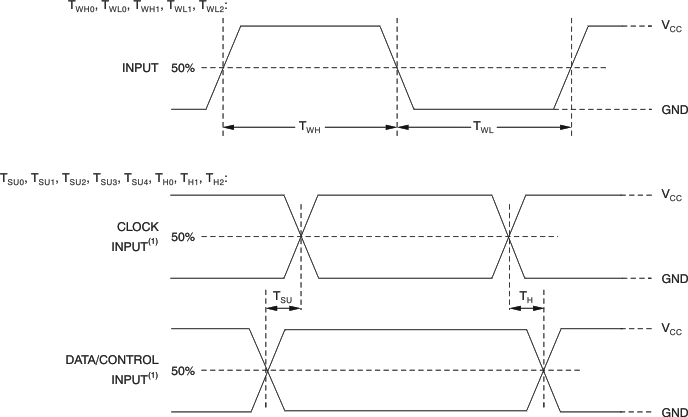
1. Input-pulse rise and fall times are 1 ns to 3 ns.
Figure 1. Input Timing
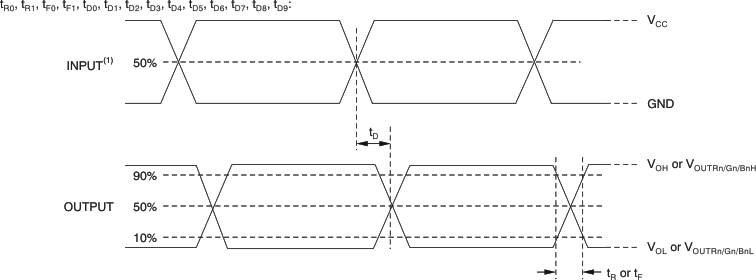
1. Input-pulse rise and fall times are 1 ns to 3 ns.
Figure 2. Output Timing
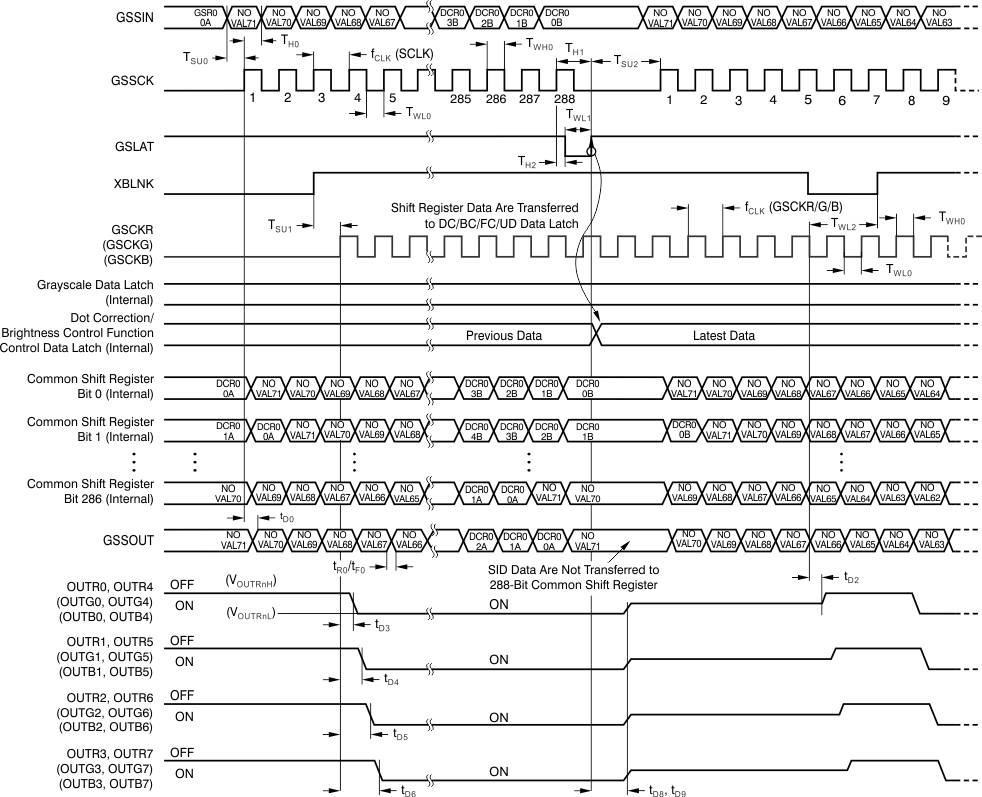 Figure 4. Dot Correction, Global Brightness Control, Function Control, and User-Defined
Figure 4. Dot Correction, Global Brightness Control, Function Control, and User-DefinedData-Write Timing From GS Data Path
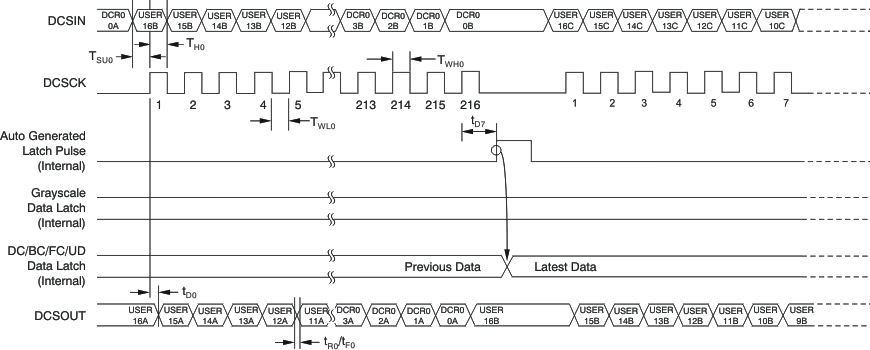 Figure 5. Dot Correction, Global Brightness Control, and Function Control
Figure 5. Dot Correction, Global Brightness Control, and Function ControlData-Write Timing From DC Data Path
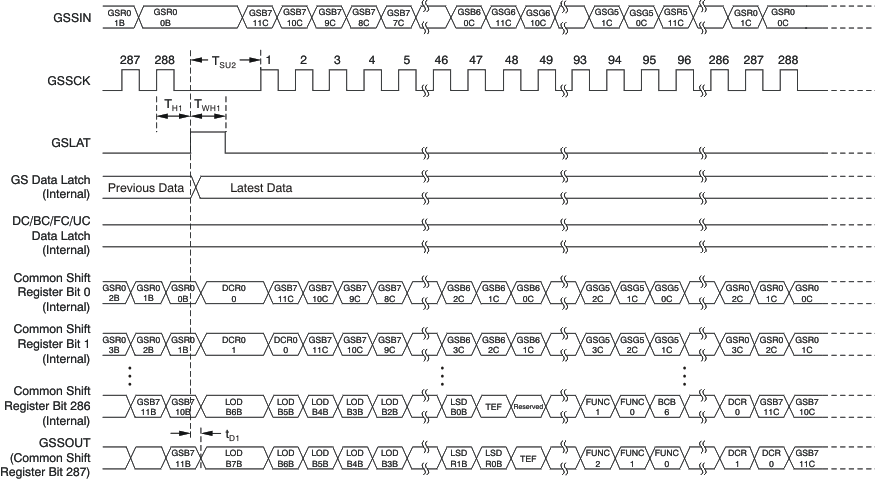 Figure 6. Status Information Data-Read Timing
Figure 6. Status Information Data-Read Timing
7.7 Typical Characteristics
at TA = 25°C and VCC = 3.3 V, unless otherwise noted